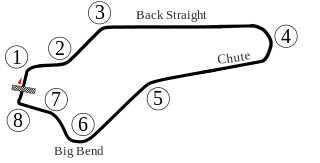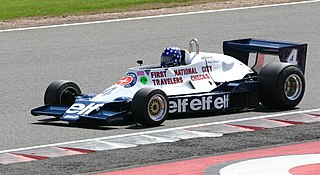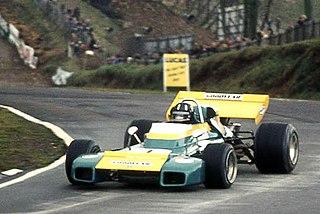Brabham is the common name for Motor Racing Developments Ltd., a British racing car manufacturer and Formula One racing team. Founded in 1960 by Australian driver Jack Brabham and British-Australian designer Ron Tauranac, the team won four Drivers' and two Constructors' World Championships in its 30-year Formula One history. Jack Brabham's 1966 FIA Drivers' Championship remains the only such achievement using a car bearing the driver's own name.

Sir John Arthur Brabham was an Australian racing driver who was Formula One World Champion in 1959, 1960, and 1966. He was a founder of the Brabham racing team and race car constructor that bore his name.

BMW has been involved in Formula One in a number of capacities since the inauguration of the World Drivers' Championship in 1950. The company entered occasional races in the 1950s and 1960s, before building the BMW M12/13 inline-four turbocharged engine in the 1980s. This engine was the result of a deal between BMW and Brabham, which resulted in the team's chassis being powered by BMW engines from 1982 until 1987, a period in which Nelson Piquet won the 1983 championship driving a Brabham BT52-BMW. BMW also supplied the M12/13 on a customer basis to the ATS, Arrows, Benetton and Ligier teams during this period, with various degrees of success. In 1988, Brabham temporarily withdrew from the sport and BMW withdrew its official backing from the engines, which were still used by the Arrows team under the Megatron badge. Turbocharged engines were banned by the revised Formula One Technical Regulations for 1989, rendering the M12/13 obsolete.

The 1966 United States Grand Prix was a Formula One motor race held on October 2, 1966, at the Watkins Glen Grand Prix Race Course in Watkins Glen, New York. It was race 8 of 9 in both the 1966 World Championship of Drivers and the 1966 International Cup for Formula One Manufacturers. The race was the ninth United States Grand Prix. It was the sixth to be held at Watkins Glen. The race was held over 108 laps of the 3.78-kilometre circuit for a total race distance of 408 kilometres.

The 1967 Formula One season was the 21st season of FIA Formula One motor racing. It featured the 1967 World Championship of Drivers and the 1967 International Cup for F1 Manufacturers, contested concurrently over an eleven race series which commenced on 2 January, and ended on 22 October. The season also included a number of non-championship races for Formula One cars. Denny Hulme won the World Championship of Drivers and Brabham-Repco was awarded the International Cup for F1 Manufacturers.
The 1966 Formula One season was the 20th season of FIA Formula One motor racing. It featured the 1966 World Championship of Drivers and the 1966 International Cup for F1 Manufacturers which were contested concurrently over a nine-race series that commenced on 22 May and ended on 23 October. The season also included a number of non-championship races for Formula One cars.
The 1962 Formula One season was the 16th season of FIA Formula One motor racing. It featured the 1962 World Championship of Drivers and the 1962 International Cup for F1 Manufacturers which were contested concurrently over a nine race series that commenced on 20 May and ended on 29 December. The season also included a number of non-championship races for Formula One cars.

Repco is an Australian automotive engineering/retailer company. Its name is an abbreviation of Replacement Parts Company and it is best known for spare parts and motor accessories.

Silvio Moser was a racing driver from Switzerland.

The Brabham BT46 is a Formula One racing car designed by Gordon Murray for the Brabham team, owned by Bernie Ecclestone, for the 1978 Formula One season. The car featured several radical design elements, one of which was the use of flat panel heat exchangers on the bodywork of the car to replace conventional water and oil radiators. It was removed before the car's race debut, never to be seen again. The cars, however, powered by a flat-12 Alfa Romeo engine, raced competitively with modified nose-mounted radiators for most of the year, driven by Niki Lauda and John Watson, winning one race in this form and scoring sufficient points for the team to finish third in the constructors championship.

The Brabham BT19 is a Formula One racing car designed by Ron Tauranac for the British Brabham team. The BT19 competed in the 1966 and 1967 Formula One World Championships and was used by Australian driver Jack Brabham to win his third World Championship in 1966. The BT19, which Brabham referred to as his "Old Nail", was the first car bearing its driver's name to win a World Championship race.

The Repco Brabham BT24 was a Formula One racing car design. It was one of three cars used by the Brabham racing team during their championship-winning 1967 Formula One season. Only three BT24 chassis were ever raced.
The 1967 Australian Drivers' Championship was a CAMS sanctioned Australian motor racing title for drivers of cars conforming to Australian National Formula or Australian 1½ Litre Formula regulations. The winner of the championship was awarded the 1967 CAMS Gold Star. It was the 11th Australian Drivers' Championship to be awarded by CAMS.

The Brabham BT3 is a Formula One racing car. It was the first Formula One design to be produced by Motor Racing Developments for the Brabham Racing Organisation, and debuted at the 1962 German Grand Prix. The Brabham BT3 was the vehicle with which team owner – then two-time World Champion – Jack Brabham, became the first driver ever to score World Championship points in a car bearing his own name, at the 1962 United States Grand Prix. The following year Brabham also became the first driver ever to win a Formula One race at the wheel of an eponymous car, again driving the BT3, at the 1963 Solitude Grand Prix. The BT3 design was modified only slightly to form the Tasman Series-specification Brabham BT4 cars.

The Brabham BT56 was a Formula One car designed by John Baldwin and Sergio Rinland and raced by the Brabham team in the 1987 Formula One season. The car was powered by the straight 4 turbocharged BMW engine and raced on Goodyear tyres. Brabham finished 8th in the 1987 Constructors Championship with 10 points scored. It was driven by Andrea de Cesaris, Riccardo Patrese and Stefano Modena; both de Cesaris and Patrese scored a 3rd place driving the BT56.

The Repco Brabham BT26 was a Formula One racing car design. A development of the previous BT24, its Repco engines were unreliable, but following a switch to Cosworth DFV engines it scored two World Championship Grand Prix wins and finished runner up in the 1969 World Constructors' Championship.

The Tyrrell 008 was a Formula One car manufactured and raced by the Tyrrell Racing Organisation team during the 1978 season. Driven by Didier Pironi and Patrick Depailler, it achieved several podium finishes including a win at the 1978 Monaco Grand Prix.

The Brabham BT7 is a Formula One racing car. It was raced by the Brabham Racing Organisation and several privateers from 1963 to 1966. A development of its predecessor, the Brabham BT3, the car proved to be competitive during 1963 and 1964, taking Dan Gurney to two victories. Technical issues prevented the BT7 from scoring better results. The car was equipped with a more reliable Hewland gearbox compared to the Colotti-Francis in the BT3. Malcolm Sayer from Jaguar Cars was consulted to give input for the revised chassis. The slick aerodynamics proved particularly strong at high speed circuits such as Monza or Spa. Its successor, the BT11, was a slightly altered BT7 aimed for customers such as Rob Walker or Jo Siffert.

The Brabham BT11 is a Formula One racing car built in 1964, mainly for use by privateers in grand prix racing, but was also used by the Brabham works team during 1964 and 1965. It was the only competitive car of the period available to privateers, recording eight podium finishes in total. The car's best results came at consecutive events in the United States and Mexico 1965, with Dan Gurney qualifying and finishing second in the latter.

The Brabham BT34 was a Formula One racing car designed by Ron Tauranac, and used by Brabham during part of the 1971 and 1972 Formula One seasons.
















